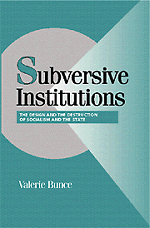Book contents
- Frontmatter
- Contents
- Preface
- 1 The Collapse of Socialism and Socialist States
- 2 Domestic Socialism: Monopoly and Deregulation
- 3 Federalism and the Soviet Bloc: Monopoly and Deregulation
- 4 Leaving Socialism
- 5 Leaving the State
- 6 Violent versus Peaceful State Dismemberment
- 7 Institutions and Opportunities: Constructing and Deconstructing Regimes and States
- Notes
- References
- Index
- Continuation of Series List
3 - Federalism and the Soviet Bloc: Monopoly and Deregulation
Published online by Cambridge University Press: 05 June 2012
- Frontmatter
- Contents
- Preface
- 1 The Collapse of Socialism and Socialist States
- 2 Domestic Socialism: Monopoly and Deregulation
- 3 Federalism and the Soviet Bloc: Monopoly and Deregulation
- 4 Leaving Socialism
- 5 Leaving the State
- 6 Violent versus Peaceful State Dismemberment
- 7 Institutions and Opportunities: Constructing and Deconstructing Regimes and States
- Notes
- References
- Index
- Continuation of Series List
Summary
Federalism is the process by which unity and diversity are politically organized. … It unites without destroying the selves that are uniting.
Carl Friedrich (1966: 286–287)It is the state that makes the nation and not the nation the state.
Colonel Jozef Pitsudski (quoted in Hobsbawm, 1992: 44–45)In the preceding chapter, we focused on institutional similarities among all the European socialist systems. As we discovered, the structure of socialism created – in theory – strong regimes, weak societies, and rapid economic growth. What happened as socialism evolved, however, was a redistribution of power from the party to the society and expanding limits on economic growth. Thus, the eventual and seemingly sudden collapse of socialism was in fact long in the making. It was the product, ironically, of the very institutions that were to preserve and protect the hegemony of the Communist Party.
While institutional commonalities provide the raw material for explaining the regionwide collapse of socialism, they are less helpful in explaining the variations in regime collapse and in the capacity of socialist states to survive the end of the regime. To address these issues, we need to shift our focus from similarities among socialist systems to differences.
In this chapter, we focus on two such differences by analyzing the institutional design of the Soviet bloc and socialist federations. As we will see, the bloc and the federations were surprisingly similar in their design and their internal dynamics.
- Type
- Chapter
- Information
- Subversive InstitutionsThe Design and the Destruction of Socialism and the State, pp. 38 - 55Publisher: Cambridge University PressPrint publication year: 1999



